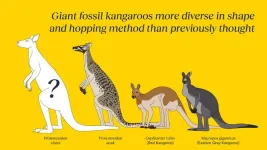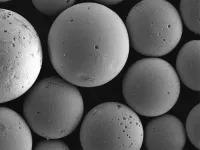(Press-News.org) How muscle changes with ageing, and tries to fight its effects, is now better understood at the cellular and molecular level with the first comprehensive atlas of ageing muscles in humans.
Researchers from the Wellcome Sanger Institute and their collaborators at Sun Yat-sen University, China applied single-cell technologies and advanced imaging to analyse human skeletal muscle samples from 17 individuals across the adult lifespan. By comparing the results, they shed new light on the many complex processes underlying age-related muscle changes.
The atlas, published today (15 April) in Nature Ageing, uncovers new cell populations that may explain why some muscle fibres age faster than others. It also identifies compensatory mechanisms the muscles employ to combat ageing.
The findings offer avenues for future therapies and interventions to improve muscle health and quality of life as we age.
This study is part of the international Human Cell Atlas initiative to map every cell type in the human body1, to transform understanding of health and disease.
As we age, our muscles progressively weaken. This can affect our ability to perform everyday activities like standing up and walking. For some people, muscle loss worsens, leading to falls, immobility, a loss of autonomy and a condition called sarcopenia2. The reasons why our muscles weaken over time have remained poorly understood.
In this new study, scientists from the Wellcome Sanger Institute and Sun Yat-sen University, China used both single-cell and single-nucleus sequencing techniques3 along with advanced imaging to analyse human muscle samples from 17 individuals aged 20 to 75.
The team discovered that genes controlling ribosomes, responsible for producing proteins, were less active in muscle stem cells from aged samples. This impairs the cells’ ability to repair and regenerate muscle fibres as we age. Further, non-muscle cell populations within these skeletal muscle samples produced more of a pro-inflammatory molecule called CCL2, attracting immune cells to the muscle and exacerbating age-related muscle deterioration.
Age-related loss of a specific fast-twitch muscle fibre subtype, key for explosive muscle performance, was also observed4. However, they discovered for the first time several compensatory mechanisms from the muscles appearing to make up for the loss. These included a shift in slow-twitch muscle fibres to express genes characteristic of the lost fast-twitch subtype, and increased regeneration of remaining fast-twitch fibre subtypes.
The team also identified specialised nuclei populations3 within the muscle fibres that help rebuild the connections between nerves and muscles that decline with age. Knockout experiments in lab-grown human muscle cells by the team confirmed the importance of these nuclei in maintaining muscle function5.
Veronika Kedlian, first author of the study from the Wellcome Sanger Institute, said: “Our unbiased, multifaceted approach to studying muscle ageing, combining different types of sequencing, imaging and investigation reveals previously unknown cellular mechanisms of ageing and highlights areas for further study.”
Professor Hongbo Zhang, senior author of the study from Sun Yat-sen University, Guangzhou, China, said: “In China, the UK and other countries, we have ageing populations, but our understanding of the ageing process itself is limited. We now have a detailed view into how muscles strive to maintain function for as long as possible, despite the effects of ageing.”
Dr Sarah Teichmann, senior author of the study from the Wellcome Sanger Institute, and co-founder of the Human Cell Atlas, said: “Through the Human Cell Atlas, we are learning about the body in unprecedented detail, from the earliest stages of human development through to old age.With these new insights into healthy skeletal muscle ageing, researchers all over the world can now explore ways to combat inflammation, boost muscle regeneration, preserve nerve connectivity, and more. Discoveries from research like this have huge potential for developing therapeutic strategies that promote healthier ageing for future generations.”
ENDS
Contact details:
Jelena Pupavac
Press Office
Wellcome Sanger Institute
Cambridge, CB10 1SA
Email: press.office@sanger.ac.uk
Notes to Editors:
1. This study is part of the Human Cell Atlas (HCA), an international collaborative consortium which is creating comprehensive reference maps of all human cells—the fundamental units of life—as a basis for understanding human health and for diagnosing, monitoring, and treating disease. The HCA is likely to impact every aspect of biology and medicine, propelling translational discoveries and applications and ultimately leading to a new era of precision medicine.
The HCA was co-founded in 2016 by Dr Sarah Teichmann at the Wellcome Sanger Institute (UK) and Dr Aviv Regev, then at the Broad Institute of MIT and Harvard (USA). A truly global initiative, there are now more than -3,400 HCA members, from 101 countries around the world. https://www.humancellatlas.org
2. Sarcopenia is an age-related condition affecting approximately 25 per cent of older people and is significantly associated with frailty. The criteria for sarcopenia include low muscle mass, low physical function and low muscle strength. There are currently no approved medications to treat sarcopenia, and current advice is to remain physically active and eat healthily to prevent its onset.
3. Nuclei contain a cell’s genetic material. Because a muscle fibre consists of just one cell, but many nuclei, it brings unique challenges for study. Both single-cell RNA sequencing and single-nucleus RNA sequencing methods were used to address these challenges. While single-cell RNA sequencing looks at individual cells, including less common types of muscle stem cells and other supporting cells, profiling muscle fibres is difficult. Single-nucleus RNA sequencing, on the other hand, can focus on the multiple cell nuclei scattered throughout the muscle cell, to better explore its genetics.
4. Intercostal muscle biopsies of eight young – between 20-40 years old – and nine aged – between 60-75 years old – donors were provided by the Cambridge Biorepository for Translational Medicine.
5. Our muscles contain different types of muscle fibres: "slow-twitch" meant for endurance activities, while others are "fast-twitch" used for powerful, explosive movements. The researchers found that with ageing, one particular subtype of the fast-twitch muscle fibres is progressively lost, called type IIx.
These data can be accessed here: https://www.muscleageingcellatlas.org
END
Human muscle map reveals how we try to fight effects of ageing
The first comprehensive cell atlas of ageing human muscle reveals the intricate genetic and cellular processes behind muscle deterioration and mechanisms to counteract it.
2024-04-15
ELSE PRESS RELEASES FROM THIS DATE:
Study shows key role of physical activity and body mass in lung function growth in childhood
2024-04-15
A new study led by the Barcelona Institute for Global Health (ISGlobal), a centre supported by the "la Caixa" Foundation, sheds light on the growth of lung function in children. The results show that increased levels of physical activity and a higher body mass index (BMI) play a key role in the recovery of early deficits. These findings, published in the journal Thorax, have important implications for clinical practice, research and public health policy, providing new insights into how to improve respiratory health from childhood to adulthood.
The study analysed data from the ...
Security vulnerability in browser interface allows computer access via graphics card
2024-04-15
Modern websites place ever greater demands on the computing power of computers. For this reason, web browsers have also had access to the computing capacities of the graphics card (Graphics Processing Unit or GPU) in addition to the CPU of a computer for a number of years. The scripting language JavaScript can utilise the resources of the GPU via programming interfaces such as WebGL and the new WebGPU standard. However, this harbours risks. Using a website with malicious JavaScript, researchers from the Institute of Applied Information Processing and Communications at Graz University of Technology (TU Graz) were able to spy on information about data, keystrokes and encryption ...
Physical activity reduces stress-related brain activity to lower cardiovascular disease risk
2024-04-15
Key Takeaways
Results from a new study indicate that physical activity may help protect against cardiovascular disease in part by reducing stress-related brain activity
This effect in the brain may help to explain why study participants with depression (a stress-related condition) experienced the greatest cardiovascular benefits from physical activity.
BOSTON – New research indicates that physical activity lowers cardiovascular disease risk in part by reducing stress-related signaling in the brain.
In the study, which was led by investigators at Massachusetts General Hospital (MGH), a founding member of the Mass General Brigham healthcare ...
Inaugural International COSPAR Planetary Protection Week: Set to inspire global collaboration in London
2024-04-15
With an increasing number of space missions targeting various celestial bodies, including Mars, Europa, and the Moon, the importance of maintaining the integrity of these environments while protecting our own biosphere has never been greater. The ICPPW will serve as a platform for promoting international collaboration and knowledge exchange on best practice in planetary protection.
The event will feature a range of sessions, meetings, as well as panel discussions, covering key topics such as the current and ...
A quarter of deaths among young adults in Canada were opioid related in 2021
2024-04-15
Premature deaths related to opioids doubled between 2019 and 2021 across Canada, with more than 1 in 4 deaths among young adults aged 20–39 years attributable to opioids, according to new research published in CMAJ (Canadian Medical Association Journal) https://www.cmaj.ca/lookup/doi/10.1503/cmaj.231339.
Opioid-related deaths have continued to increase over the past decade across Canada, with 6222 deaths occurring in 2021. This trend worsened during the COVID-19 pandemic, although the scale and rapidity of increases varied across provinces and territories. ...
Severe morning sickness: how to diagnose and treat
2024-04-15
Severe morning sickness in pregnancy, known medically as hyperemesis gravidarum, can negatively affect both maternal and infant health. A review published in CMAJ (Canadian Medical Association Journal) https://www.cmaj.ca/lookup/doi/10.1503/cmaj.221502 provides information to clinicians on the causes, diagnosis, and treatment of the condition.
Although nausea and vomiting are common in pregnancy, affecting as many as 70% of pregnancies, severe vomiting and nausea can prevent people from eating and drinking sufficiently, leading to weight loss and ...
Digging up new species of Australia and New Guinea’s giant fossil kangaroos
2024-04-15
Palaeontologists from Flinders University have described three unusual new species of giant fossil kangaroo from Australia and New Guinea, finding them more diverse in shape, range and hopping method than previously thought.
The three new species are of the extinct genus Protemnodon, which lived from around 5 million to 40,000 years ago – with one about double the size of the largest red kangaroo living today.
The research follows the discovery of multiple complete fossil kangaroo skeletons from Lake Callabonna in arid South Australia in 2013, 2018 and 2019. These extraordinary fossils allowed lead researcher ...
Carbon beads help restore healthy gut microbiome and reduce liver disease progression
2024-04-15
Innovative carbon beads, invented by researchers at UCL, reduce bad bacteria and inflammation in animal models, which are linked to liver cirrhosis and other serious health issues.
The study, published in Gut, found that the carbon beads, licensed to UCL-spinout Yaqrit, were effective in restoring gut health and had a positive impact on liver, kidney and brain function in rats and mice. They were also found to be safe for human use.
The next step will be to see if the same benefits can be realised in humans, which would ...
School suspensions and exclusions put vulnerable children at risk
2024-04-15
Managing problematic student behaviour is one of the most persistent, challenging, and controversial issues facing schools today. Yet despite best intentions to build a more inclusive and punitive-free education system, school suspensions and expulsions remain.
Now, new research from the University of South Australia shows that exclusionary practices not only fail to identify the deep-rooted causes of challenging student behaviours but exacerbate negative issues rather than resolve them.
Lead researcher, UniSA’s Professor Anna Sullivan, says schools face difficult decisions around ...
Tuberculosis can have a lasting impact on the lung health of individuals who have been successfully treated for the disease
2024-04-15
Finding strongly indicates that post-TB lung disease is an under-recognised global challenge, UK researchers say
**Note: the release below is a special early release from the ESCMID Global Congress (formerly ECCMID, Barcelona, Spain, 27-30 April). Please credit the congress if you use this story**
**ECCMID has now changed name to ESCMID Global, please credit ESCMID Global Congress in all future stories**
New research being presented at this year’s ESCMID Global Congress (formerly ECCMID) in Barcelona, Spain (27-30 ...
LAST 30 PRESS RELEASES:
Interaction of climate change and human activity and its impact on plant diversity in Qinghai-Tibet plateau
From addressing uncertainty to national strategy: an interpretation of Professor Lim Siong Guan’s views
Clinical trials on AI language model use in digestive healthcare
Scientists improve robotic visual–inertial trajectory localization accuracy using cross-modal interaction and selection techniques
Correlation between cancer cachexia and immune-related adverse events in HCC
Human adipose tissue: a new source for functional organoids
Metro lines double as freight highways during off-peak hours, Beijing study shows
Biomedical functions and applications of nanomaterials in tumor diagnosis and treatment: perspectives from ophthalmic oncology
3D imaging unveils how passivation improves perovskite solar cell performance
Enriching framework Al sites in 8-membered rings of Cu-SSZ-39 zeolite to enhance low-temperature ammonia selective catalytic reduction performance
AI-powered RNA drug development: a new frontier in therapeutics
Decoupling the HOR enhancement on PtRu: Dynamically matching interfacial water to reaction coordinates
Sulfur isn’t poisonous when it synergistically acts with phosphine in olefins hydroformylation
URI researchers uncover molecular mechanisms behind speciation in corals
Chitin based carbon aerogel offers a cleaner way to store thermal energy
Tracing hidden sources of nitrate pollution in rapidly changing rural urban landscapes
Viruses on plastic pollution may quietly accelerate the spread of antibiotic resistance
Three UH Rainbow Babies & Children’s faculty elected to prestigious American Pediatric Society
Tunnel resilience models unveiled to aid post-earthquake recovery
Satellite communication systems: the future of 5G/6G connectivity
Space computing power networks: a new frontier for satellite technologies
Experiments advance potential of protein that makes hydrogen sulfide as a therapeutic target for Alzheimer’s disease
Examining private equity’s role in fertility care
Current Molecular Pharmacology achieves a landmark: real-time CiteScore advances to 7.2
Skeletal muscle epigenetic clocks developed using postmortem tissue from an Asian population
Estimating unemployment rates with social media data
Climate policies can backfire by eroding “green” values, study finds
Too much screen time too soon? A*STAR study links infant screen exposure to brain changes and teen anxiety
Global psychiatry mourns Professor Dan Stein, visionary who transformed mental health science across Africa and beyond
KIST develops eco-friendly palladium recovery technology to safeguard resource security
[Press-News.org] Human muscle map reveals how we try to fight effects of ageingThe first comprehensive cell atlas of ageing human muscle reveals the intricate genetic and cellular processes behind muscle deterioration and mechanisms to counteract it.


